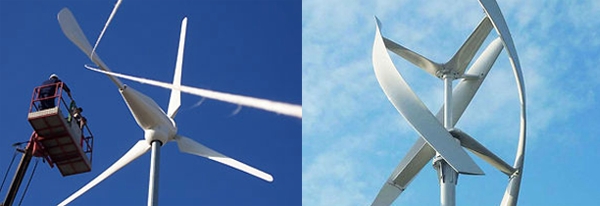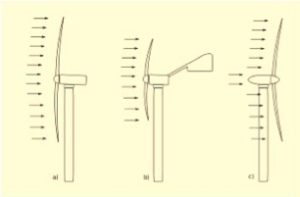Small wind
Vertical or Horizontal Wind Turbines use the kinetic energy of the wind to generate electricity. First kinetic energy is converted into mechanical energy, which is then converted by a generator to electrical energy. The efficiency of wind turbines depends on 3 major factors: wind power, blade aerodynamics and air density.
Generator can be connected directly to the rotor winding (Direct drive), or both connected to a gearbox. The generator can be synchronous or asynchronous.
Wind turbines can be separated into two basic types determined by which way the turbine spins:
- Horizontal axis , wind turbines have the main rotor shaft and electrical generator at the top of a tower and the axis of rotation is parallel to the ground. Generally installed in open spaces featuring laminar wind;
- Vertical axis, wind turbines have the main rotor shaft arranged vertically, so the axis of rotation is orthogonal to the ground. Commonly installed in open or urban spaces with turbulent wind.
and into these two other basic types, determined by the power (or Installed driving power):
- micro wind turbines with a generating capacity of less than 20kW
- small wind turbines with a generating capacity power from 20 kW to 200 kW

In the following subsections we wanted to point out some aspects related to the types of generator (synchronous and asynchronous), to their sophisticated systems of regulation and control, able to instantly adjust the working conditions of the machine once the speed and the direction of the winds change. Wind turbines are also equipped with braking systems and other mechanisms that protect, in case of extreme wind, the proper functioning and integrity of the wind turbine.
The blades start to move when the wind speed reaches the minimum start-up (cut-in wind speed). The cut-in thresholds are variable and depend on the size of the generator: usually even very low wind speeds (3-4 meters per second) are enough to start small wind turbines. The rotation of the rotor, for wind turbines with horizontal axis, can be upwind [Figs. a) b)] or downwind fig. c).

As the wind speed increases, the instantaneous power of the turbine progressively increases, until the attainment of the nominal speed (rated wind speed), or wind speed wherein the generator reaches the “Name Plate Output”. The peak power output remains constant until the maximum wind speed threshold (cut-out wind speed). Beyond this tolerated threshold, the generator stops producing energy and starts the safe mode, using systems of protection, in order to avoid damage to the mechanical components.
ASYNCHRONOUS GENERATOR
Rotor and generator can be connected directly (Direct drive), or connected together to a gearbox. The generator can be synchronous or asynchronous.
The main advantage of the asynchronous generator is the constancy of frequency, that is independent of the speed of rotation of the blades. In most cases, given the non-constancy of the speed of rotation of the blades, synchronous generator would seem the most natural choice.
Moreover asynchronous generator is low-cost and makes a yield higher than that of the synchronous generator.
The disadvantages are: the need to absorb the balance of “reactive power” for its operation, so it needs to be connected to the network or, if in the island, to get a suitable capacitor bank to provide reactive power. Moreover a small wind system with asynchronous generator, in order to guarantee good quality energy, requires special maintenance and several annual inspections.
SYNCHRONOUS GENERATOR
Synchronous generators are permanent magnets; they generate variable frequency energy, which depends on the speed of the wind. By installing a frequency inverter the problem of the frequency is solved; it provides input to straighten the variable frequency current, turning it constantly and making a new conversion from DC to AC power frequency.
Advantages: Does not require a fixed number of turns. This is of course an advantage considering that the wind is not always constant. It auto- magnetizes, it does not need current for the starter, and then does not absorb current from the connection box. It does not create any difference to the network because it is separated from the mains, with a very advanced electronic system for the commissioning phase on the network.
Disadvantages: Cost of energy transformation.
POWER CONTROL
The power control system is able to optimize the power output on the variation of the wind speed.
There are two types of power control systems:
- Pitch control: the blades are designed in order to rotate around its axis. This is an automated form of control, which increases or reduces the surface area exposed to the wind and thus changes the aerodynamic efficiency of the blades.
- Stall control: the blades do not rotate around its axis, as they are constrained to the hub. The aerodynamic design of the blades control the power. This is defined as passive type power control. Furthermore, the turbines are equipped with brake systems, which ensure the slow down of the speed rotation of the rotor, up to the maximum threshold of wind tolerated (cut-out wind speed). Beyond the cut-off speed, the turbine stops producing energy and provides security through:
- a complete stop of the rotor
or
- the misalignment between the axis of the rotor and the rotational axis of the blade.
The Micro and Small wind turbines use mainly the latter solution, which does not require the presence of electronic devices. Simply, because of the presence of a "hinge", when the rotor reaches the cut-off speed, it will rotate vertically on its own axis.
YAW CONTROL SYSTEM
The yaw system of wind turbines is the component responsible for the orientation of the wind turbine rotor towards the wind. The yaw is the rotation of the turbine around its vertical axis, which is needed to position the rotor according to the wind direction. The yaw control also helps to regulate the produced power.
The two main systems of yaw control and regulation are:
• Active Yaw Control: medium and large size turbines are equipped with a sophisticated servomechanism, regulated by an anemometer, which ensures the optimal alignment between the rotor axis and the wind direction.
• Passive yaw-control: to orient the spacecraft based on the direction of the wind, small size turbines have a simple directional shaft (or a wind vane).
